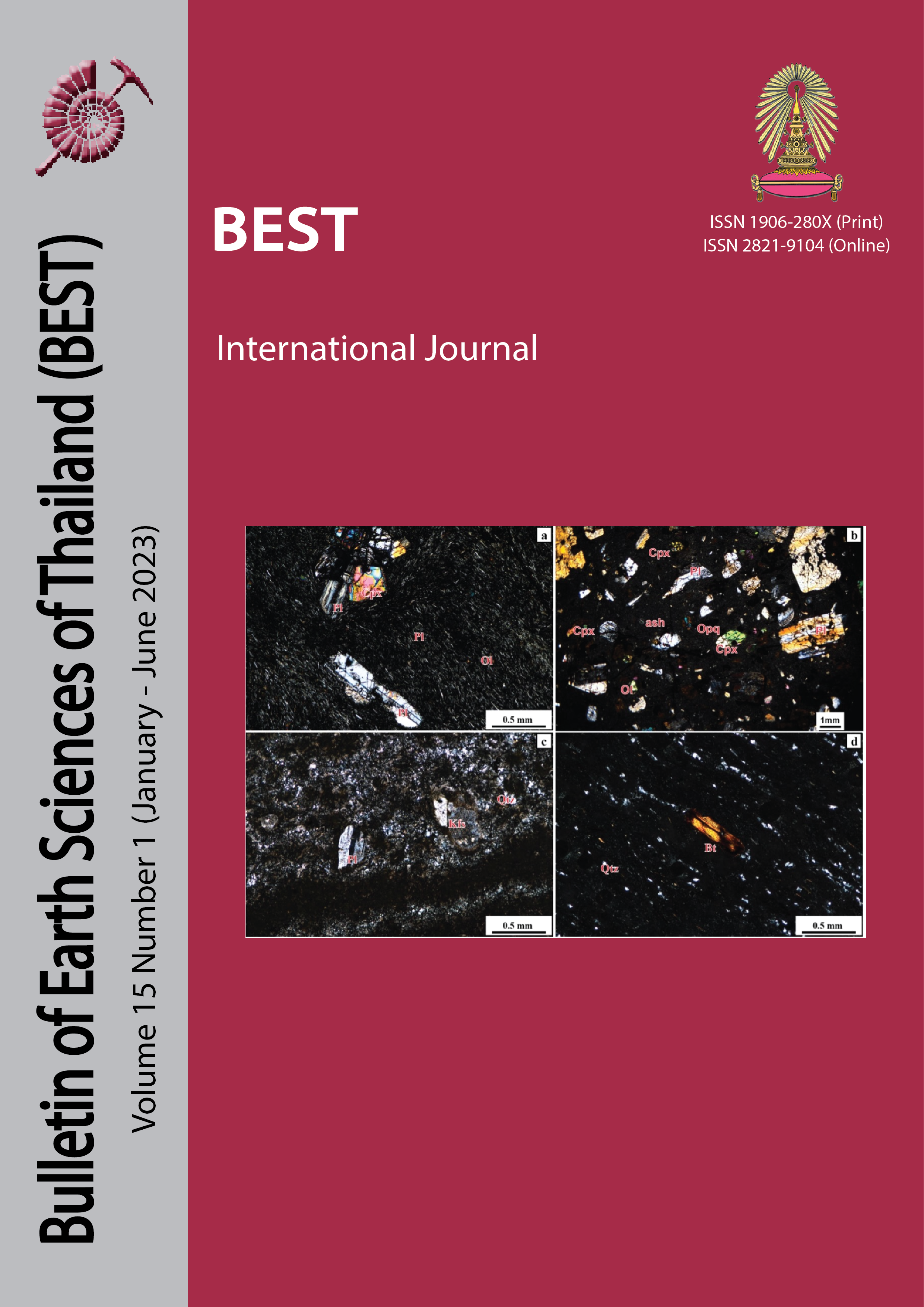Remote sensing and mineral analysis of residual basalt from Khao Kradong area, Buriram, northeastern Thailand for jasmine rice growth experiment
Main Article Content
Abstract
Residual basaltic soil contains various primary, secondary, and micronutrients, including some unique plant characteristics such as the fragrance of rice. This paper shows the application of remote sensing coupled with X-Ray diffraction and X-Ray fluorescence analyses to locate the appropriate sites of residual basalt for the re-soil process of the jasmine rice growth experiment. We focused the geological investigation on the Khao Kradong National Park and the surrounding areas where an extinct volcano is located. The three series of satellite images were interpreted. As a result, we determined three target areas for excavating the residual soils. Fifty-four soil samples from seven profiles were analyzed by XRD and XRF. In conclusion, we found that the area behind Huai Rat Sub-district Administrative Organization to the south, about 0.8 km, is the most suitable among all the basaltic residual soil sites that contain environmentally and chemically micronutrients appropriate to test the growth rate of jasmine rice.
Article Details

This work is licensed under a Creative Commons Attribution-NonCommercial-NoDerivatives 4.0 International License.
Copyright © 2008 Department of Geology, Faculty of Science, Chulalongkorn University. Parts of an article can be photocopied or reproduced without prior written permission from the author(s), but due acknowledgments should be stated or cited accordingly.
References
Artyszak, A., (2018). Effect of silicon fertilization on crop yield quantity and quality - a literature review in Europe. Biochem, 127, 152–160.
Bradbury, L. M. T., Fitzgerald, T. L., Henry, R. J., Jin, Q., and Waters D. L. E., (2005). The gene for fragrance in rice. Plant Biotechnology Journal, 3, 363-370.
Changsri, R., (2015). Factors affecting the quality of Thai Hom Mali Rice. Rice Department Rice Research and Development Division, Ubon Ratchathani Rice Research Center
Choudhury, P. R., Kohli, S., Srinivasan, K., Mohapatra, T. and Sharma, R. P., (2001). Identification and classification of aromatic rice based on DNA fingerprinting. Euphotic, 118, 243-251.
Eneji, A.E., Inanaga, S., Muranaka, S., Li, J., Hattori, T., An, P., Tsuji, W., (2008). Growth and nutrient use in four grasses under drought stress as mediated by silicon fertilizers. J. Plant Nutr, 31, 355–365.
Imtiaz, M. S., Rizwan, M. A., Mushtaq, M., Ashraf, S. M., Shahzad, B., Yousaf, B, et al (2016). Silicon occurrence, uptake, transport and mechanisms of heavy metals, minerals and salinity enhanced tolerance in plants with future prospects: A review. Journal of Environmental Management, 183, 521-529.
Kamonwan R., Srisawat k., Sureeporn, K., (2013). Fragrance Gene and Molecular Basis of Fragrant Rice. Thai J. Genet 6(2), 93-114.
Ndikuryayo C., Ndayiragije A., Kilasi N. and Kusolwa P., (2022) breeding for Rice Aroma and Drought Tolerance: A Review Agronomy, 12 (7).
Rodrigues F.A., Datnoff L.E. (Eds) (2015) Silicon and Plant Diseases, Springer, Switzerland, pp 7-51.
Singer A. and Ben-Dor E. (1987). Origin of red clays layer interbedded with basalt of Golan Heights. Geoderma, 39, 293-306.


